6.13 Essen gehen

Guten Abend!
Zum Aufwärmen machen wir unseren Tagesminiplausch und eine Wiederholung.
Wiederholung
In the previous lesson, you learned what to expect at der Wochenmarkt und die Spezialgeschäfte. Let’s review what you have learned.
Wo kauft man frisches Obst? Wo kauft man Fleisch? Wo kauft man Brot? Think back on the names of the specialty shops you learned in the previous lesson. Then answer the questions in a complete sentence. For example: Man kauft frischen Käse in der Käserei.
Lektionsüberblick
Much like in America, many people enjoy dining out in Germany, so it’s important to know how to navigate the restaurant scene. In the end, you will be able to 1) ask someone where they’d like to eat, 2) read a menu, 3) order your meal, and 4) pay for your meal.
Was weißt du schon?
Let’s do a quick skills check before moving on to new material. Drag the food items into the type of store where one might shop for them in Germany.
| Noch nicht start klar?
Du kannst immer auf die gleiche 1010-Lektion zurückgreifen! |
Not confident about starting this lesson?
You can always review the same Lektion from 1010. |
1) Wo wollen wir essen?
In major metropolitan areas in German-speaking countries, there is no shortage of different types of restaurants and international (or more traditional) cuisine. Imagine you are talking with a friend about where to eat tonight. The conversation might go like this…
Du: Wo wollen wir essen?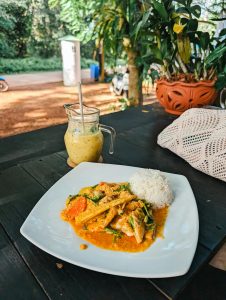
Freund: Vielleicht beim Italiener?
Du: Ich esse nicht gern Pasta. Vielleicht etwas Asiatisches?
Freund: Okay, wie wär’s mit dem Thai-Restaurant?
Du: Gute Idee! Das Restaurant hat auch vegetarisches Essen.
Freund: Ja, genau. Dann gehen wir da hin.
Du: Super, ich hab’ Hunger!
Let’s practice!
Jetzt bist du dran!
Österreich im Blickpunkt
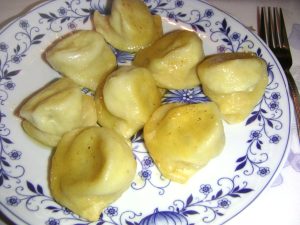 Die Kärntner Nudel ist ein dünn ausgewalzter Nudelteig, der zu einer bis zu faustgroßen Tasche geformt und mit verschiedenen Zutaten gefüllt wird. Kärntner Nudeln gibt es mit verschiedensten Füllungen, von herzhaft bis süß, angefangen von der „Kasnudel“ (mit einer Topfen*-Füllung) über die Fleischnudel, die Erdäpfelnudel und die „Herrnpilznudel“ (mit Steinpilz-Füllung) bis zu den süßen Apfelnudeln (Apfel-Zimt-Füllung) und Kletzennudeln (gedörrte Birnen mit Topfen).
Die Kärntner Nudel ist ein dünn ausgewalzter Nudelteig, der zu einer bis zu faustgroßen Tasche geformt und mit verschiedenen Zutaten gefüllt wird. Kärntner Nudeln gibt es mit verschiedensten Füllungen, von herzhaft bis süß, angefangen von der „Kasnudel“ (mit einer Topfen*-Füllung) über die Fleischnudel, die Erdäpfelnudel und die „Herrnpilznudel“ (mit Steinpilz-Füllung) bis zu den süßen Apfelnudeln (Apfel-Zimt-Füllung) und Kletzennudeln (gedörrte Birnen mit Topfen).
*Topfen is called Quark in Germany, Switzerland, and Liechtenstein.
The Carinthian noodle is a thinly rolled out pasta dough, formed into a fist-sized pocket and filled with various ingredients. Carinthian noodles are available with a variety of fillings, from savory to sweet, ranging from Kasnudel (with a curd cheese filling), to meat noodles, potato noodles, and Herrnpilznudel (with porcini mushroom filling), to sweet apple noodles (apple and cinnamon filling) and Kletzennudeln (dried pears with curd cheese).
2) Die Speisekarte (the menu)
Although many restaurants in German-speaking countries post their menu on a sign outside of the restaurant, you will most likely receive a Speisekarte once you are at your table. You will already recognize many of the words you might find there. Consider the Gerichte (dishes), Beilagen (side dishes), and Getränke (drinks) you have learned. You might also notice Vorspeise. What do you remember about the meaning of this word?
Let’s practice with some Speisekarte comprehension questions. Answer each question below.
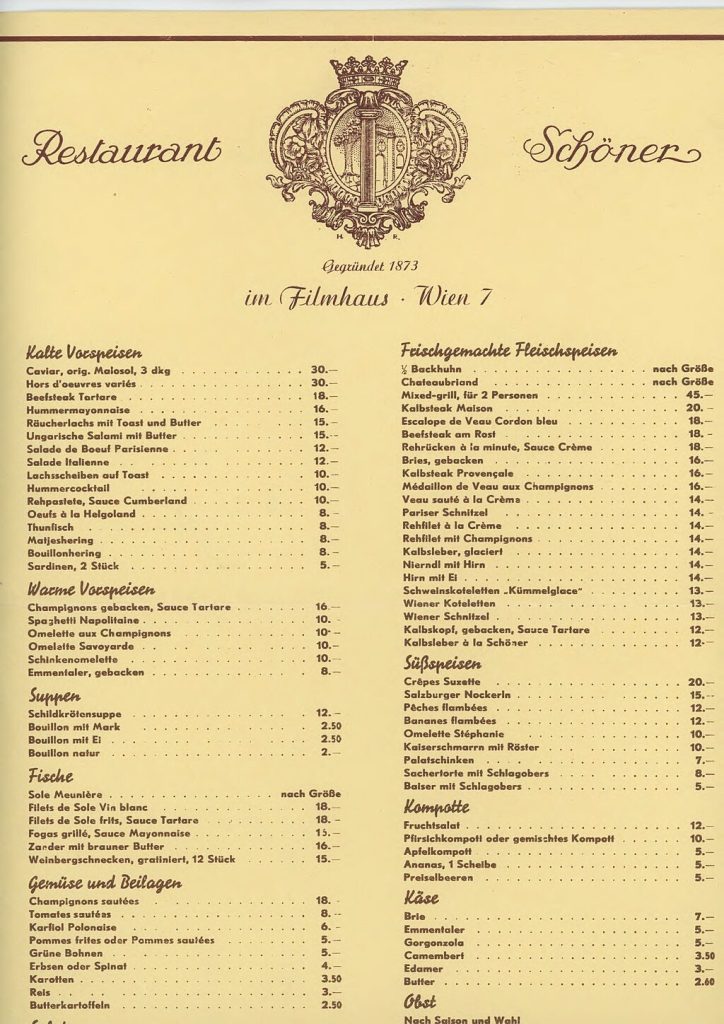 |
|
Did you notice that the Vorspeisen have two lists – kalte Vorspeisen and warme Vorspeisen? Did you discover the word for Nachtisch? That’s right! Süßspeisen = sweet foods.
You can take a look at this additional resource to review and expand your restaurant vocabulary.
Jetzt bist du dran!
3) Ich hätte gern…
As is most languages there is more than one way to order politely. You already know one way, Ich möchte… Read and listen to other ways to order. Can you pick out the alternate way to order? Then read and listen to the second panel. Do you understand what is happening?
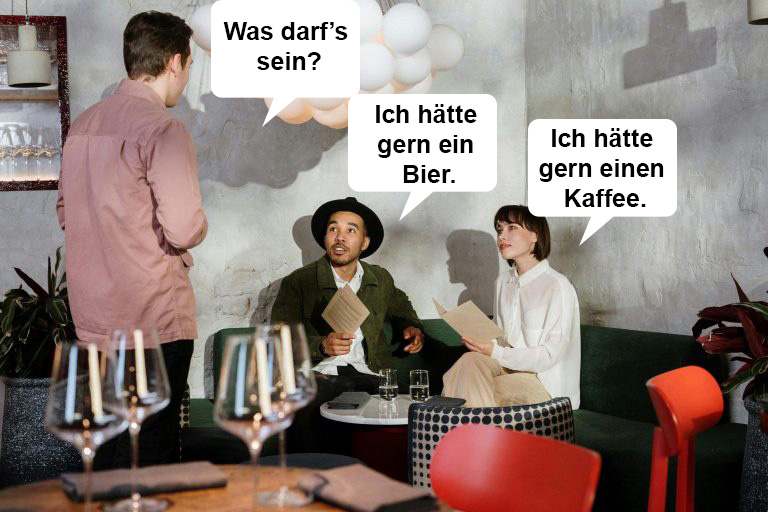 |
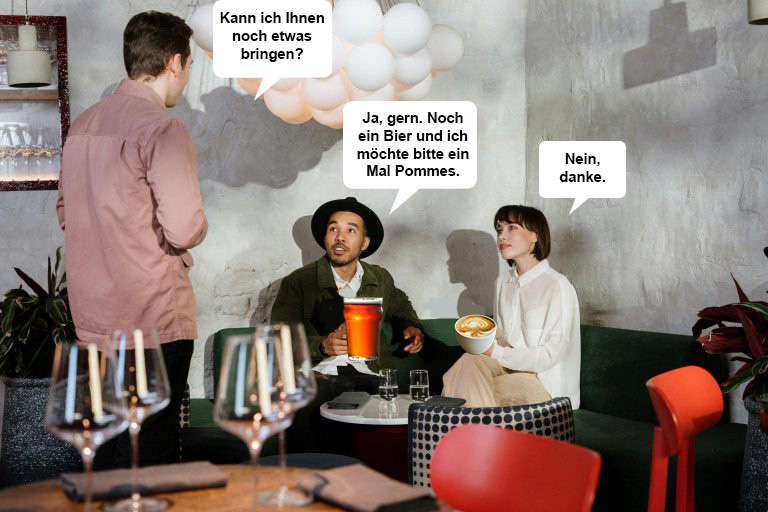 |
Now let’s check your comprehension.
Jetzt bist du dran!
4) Zahlen, bitte! (I’d/we’d like to pay.)
Your time at the restaurant is just about over, but first you have to pay. Listen and repeat how to ask for your check and how to ask if you can pay with a credit card.
 |
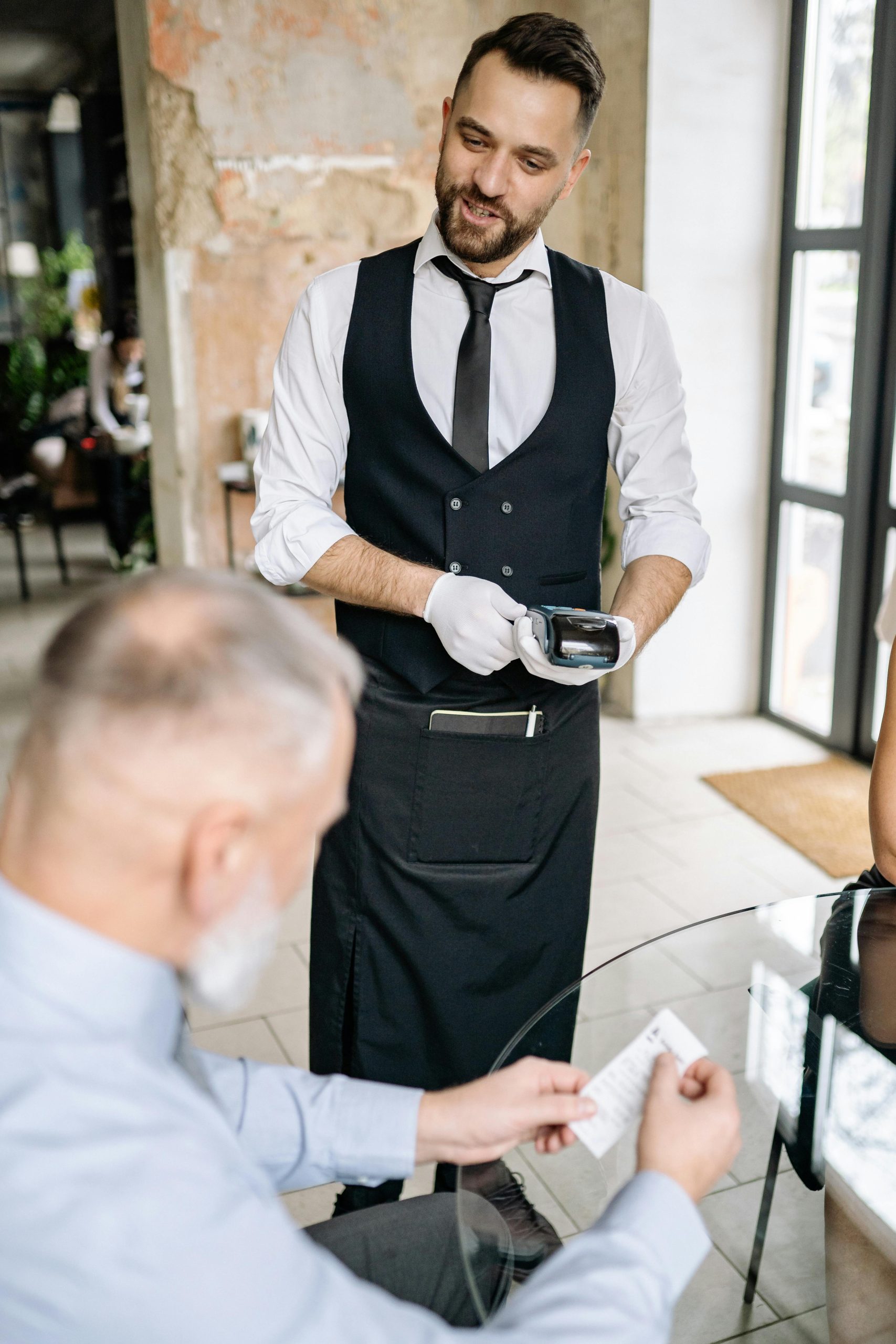 |
| Zahlen, bitte! | Kann ich mit Karte zahlen? |
Your waiter might also ask you the following ja oder nein question.
Hat Ihnen alles geschmeckt?
You can answer with….Ja, danke or leider nein .
🎥You can watch as the bill for pizza delivery is paid on Nico’s Weg.
Kleiner Hinweis
Tipping is different between the United States and German-speaking countries. When you pay a bill in German-speaking Europe, you only give a small tip (das Trinkgeld) as the service charge is included in the bill. Waitresses and waiters get higher hourly wages than in the North American context. Therefore, people usually tip less; you just round up to the nearest currency unit (9,20€ -> you would give 10€), or if the bill is larger, you round up and add a couple of Euros (37,40€ -> you would give 40€).
Example: How to tip 0,80€ on the 9,20€
- Hand the server a 10€ bill (or two 5€ bills) and say “Das stimmt so.” The server knows not to give you any change.
- Hand the server a bill larger than 10€ and say “10 Euro”. The server knows to give you back change from the 10€. (E.g. If you have handed them a 20€ bill, you will get a 10€ bill back.)
- Hand the server your card and say “10 Euro”. The server knows to charge you 10€ on your card. You typically do not enter a tip on the receipt.
Jetzt bist du dran!
Zum Schluß

*As you conclude this lesson, don’t forget to check Canvas!*
Before you go!
 You have completed your second semester of German! Herzlichen Glückwünsch! Think about all you have accomplished this semester. If you were traveling to a German-speaking country over break, you would already be able to have a solid conversation with a German-speaker.
You have completed your second semester of German! Herzlichen Glückwünsch! Think about all you have accomplished this semester. If you were traveling to a German-speaking country over break, you would already be able to have a solid conversation with a German-speaker.
Don’t end your language journey here, be sure to sign up for your next class (GERM 2030) and make plans to study abroad.
As you go forward in your language learning (or want to keep up over break), you can always come back to this book (and Deutsch im Alltag I) to review!

Media Attributions
- Specialty Shop activity adapted from Grenzenlos Deutsch, licensed under a CC BY-NC-SA 4.0 International License.
- Kleiner Hinweis about Tipping was adapted from Willkommen: Deutsch für alle Copyright © 2020 by Claudia Kost and Crystal Sawatzky is licensed under a CC BY-NC-SA 4.0 International License.
Media Attributions
- Photo of Thai food by pexels-markus-winkler-1430818-19915907
- Private:
- fireworks-1993221_1280

